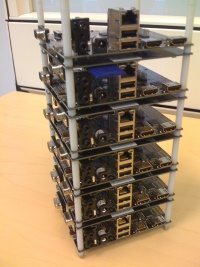
Pandaboard
The Pandaboard is an open OMAP™ 4 mobile software development platform. It provides users with either a desktop or text-based environment.
Technical Specifications
- 1 GHz Dual core Cortex A9 Processor (OMAP 4430-4460)
- 1 GB DDR2 RAM
- HDMI v1.3
- 10/100Mbit/s Ethernet
- 802.11 b/g/n WiFi
For more information on the Pandaboard visit their website.
Running Fedora on a Pandaboard
This page will give you detailed instructions for running Fedora 18 Beta on your Pandaboard. The provided image will provide both serial console and the XFCE desktop.
Download the image
The first step is to download the prebuilt Fedora 18 Beta image, which includes everything you will need to boot your system. It will require a minimum of 4GB for the root filesystem.
Download and verify the checksum:
wget http://dl.fedoraproject.org/pub/fedora-secondary/releases/test/18-Beta/Images/armhfp/Fedora-18-Beta-armhfp-Images-CHECKSUM sha256sum --check Fedora-18-Beta-armhfp-Images-CHECKSUM
Writing the Image
Linux Users
You can write the image to an SD card of your choosing but it does have to meet the minimum size requirements of 4GB. You can optionally use a USB device for the root file system to improve performance.
For use with SD:
xzcat Fedora-18-Beta-panda-armhfp.img.xz > /dev/<path-to-SD-device>
For use with SD/USB
xzcat Fedora-18-Beta-panda-armhfp.img.xz > /dev/<path-to-SD-device> xzcat Fedora-18-Beta-panda-armhfp.img.xz > /dev/<path-to-USB-device>
Then use fdisk to delete the boot partition from the USB attached media, and rootfs and swap partitions from the SD card.
fdisk /dev/<path-to-SD-device>
Delete partitions two and three (d,3,d,2,w).
fdisk /dev/<path-to-USB-device>
Delete the first parition only. (d,1,w)
Once completed run the below command to ensure the entire image is written to the card:
sync
Windows Users
- You will need to download Win32 Image Writer as well as a tool to extract the image such as 7-Zip.
- Once downloaded and installed right click on the disk image and select "7-Zip->Extract files here"
- Launch Win 32 Disk Imager and select the extracted disk image and the SD card you would like to write the files to. Click "Write". Be very careful during this step - all data on the selected drive will be lost!
Using Fedora on the Pandaboard
Connect the newly created media to your Pandaboard and power on. No further steps are required. Your images will boot to graphical.target (runlevel 5) by default. To change this default behaviour and boot to multi-user.target (runlevel 3) run the following command as root:
ln -sf /lib/systemd/system/runlevel3.target /etc/systemd/system/default.target
The default root password is "fedora". This should be changed immediately.
Release Notes
- This test image includes the updates-testing repository enabled by default.
- Images were composed using tools in Fedora 17 due to continuing work on Fedora 18.
- When using this image the system will automatically reboot to repartition the root filesystem on first boot. This will expand the size of the root partition to use all available space on the device. To prevent this, delete the '.rootfs-repartition' flag in '/' or pass a kernel command line argument of 'nofsresize'.
Additional Support
There are Fedora ARM users all around the globe - if you need assistance, would like to provide feedback or contribute to Fedora ARM please visit us on the IRC - we can be found in #fedora-arm on Freenode. You can also contact us on the mailing list - arm@lists.fedoraproject.org
